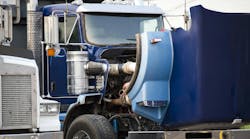Given overall economic conditions and the poor freight market, it's not surprising that foot traffic on the floor of the Mid-America Trucking Show was down by about 8% compared to last year. And with truck sales following freight into some of the most depressed levels experienced in decades, it's also no surprise that two of the major truck brands chose not to attend this year, and those that did generally downsized their displays.
Yet despite the generally gloomy conditions, everyone from CEOs on podiums to drivers walking the show seemed ready to talk about the industry's eventual recovery. And as usual, there were plenty of new products and technologies on display to help trucking take advantage of that better future whenever it might arrive, as the next 14 pages of show coverage plainly illustrate.
While the general economy was certainly the main topic of conversation, a more industry-specific issue generated most of the heated discussions around the show floor — selective catalytic reduction (SCR).
With the next federally mandated drop in diesel emissions only nine months away, truck and engine manufacturers are now in the final stages of fine tuning the systems that will bring them into compliance with the 2010 regulations. All but one have chosen to use SCR aftertreatment technology as their 2010 solution. The lone wolf in the non-SCR camp will use what it calls “an in-cylinder solution.” Both sides came to MATS ready to promote their approach as best, and by sometimes not so subtle public statements criticize the other.
At an SCR users' forum held on the first day of the show, CEOs representing truck manufacturers, truckstop operators and the market's one remaining independent diesel engine maker pressed the advantages of their chosen emissions solution.
In short, they said SCR will improve diesel fuel economy significantly from current levels, relies on a simple chemical reaction, and has been proven reliable in widespread use in Europe. The diesel emissions fluid (DEF) required by SCR systems is a nontoxic blend of water and urea, they said, and will be available across the U.S. and Canada at truckstops, truck dealerships and independent distributors. They also pointed out that SCR-equipped engines will meet the 2010 emissions requirement of 0.02 grams of NOx and will not require the use of emissions credits that allow engines emitting up to 0.05 grams to be certified for sale until 2012.
The night before at a gala customer event in the Kentucky Fair Ground's Freedom Hall arena, the benefits of in-cylinder approach received their MATS airing. Using much higher levels of exhaust gas recirculation (EGR) to achieve acceptable NOx levels without SCR avoids the added weight of that aftertreatment system and doesn't require a second DEF tank that needs to be refilled, eliminating issues of DEF cost and availability. As for its 0.05 NOx emissions, the non-SCR approach is using an emissions credits system designed by the Federal Environmental Protection Agency to reward manufacturers who have produced diesels over the past few years that voluntarily exceed current emissions performance standards, the in-cylinder supporters pointed out.
And so the argument carried out to the show floor for the next three days, with the individual manufacturers' displays educating the trucking public on the advantages of their chosen 2010 technology.
While the talk of emissions strategies and slow truck sales certainly commanded much attention, it shouldn't be overlooked that some 935 exhibitors were on hand at MATS this year. Electric, hybrid and alternative fuel trucks attested to the industry's green commitment, as did a wide variety of new components and services addressing fuel economy improvements. Safety, too, was a common theme, as component and truck manufacturers rolled out commercially ready advanced safety systems as well as prototypes not far from production. As always, truck maintenance, performance and appearance products and services filled hundreds of booths.
In short, the 2009 edition of the industry's major public event offered concrete examples of trucking's continued vibrancy despite its economic and technical challenges.
— JIM MELE


